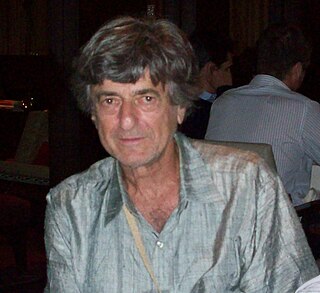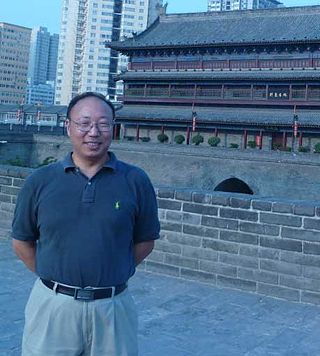Related Research Articles

Chaos theory is an interdisciplinary area of scientific study and branch of mathematics. It focuses on underlying patterns and deterministic laws of dynamical systems that are highly sensitive to initial conditions. These were once thought to have completely random states of disorder and irregularities. Chaos theory states that within the apparent randomness of chaotic complex systems, there are underlying patterns, interconnection, constant feedback loops, repetition, self-similarity, fractals and self-organization. The butterfly effect, an underlying principle of chaos, describes how a small change in one state of a deterministic nonlinear system can result in large differences in a later state. A metaphor for this behavior is that a butterfly flapping its wings in Brazil can cause a tornado in Texas.

In mathematics, a dynamical system is a system in which a function describes the time dependence of a point in an ambient space, such as in a parametric curve. Examples include the mathematical models that describe the swinging of a clock pendulum, the flow of water in a pipe, the random motion of particles in the air, and the number of fish each springtime in a lake. The most general definition unifies several concepts in mathematics such as ordinary differential equations and ergodic theory by allowing different choices of the space and how time is measured. Time can be measured by integers, by real or complex numbers or can be a more general algebraic object, losing the memory of its physical origin, and the space may be a manifold or simply a set, without the need of a smooth space-time structure defined on it.
In mathematics and science, a nonlinear system is a system in which the change of the output is not proportional to the change of the input. Nonlinear problems are of interest to engineers, biologists, physicists, mathematicians, and many other scientists since most systems are inherently nonlinear in nature. Nonlinear dynamical systems, describing changes in variables over time, may appear chaotic, unpredictable, or counterintuitive, contrasting with much simpler linear systems.

Mathematical physics refers to the development of mathematical methods for application to problems in physics. The Journal of Mathematical Physics defines the field as "the application of mathematics to problems in physics and the development of mathematical methods suitable for such applications and for the formulation of physical theories". An alternative definition would also include those mathematics that are inspired by physics, known as physical mathematics.

Dynamical systems theory is an area of mathematics used to describe the behavior of complex dynamical systems, usually by employing differential equations or difference equations. When differential equations are employed, the theory is called continuous dynamical systems. From a physical point of view, continuous dynamical systems is a generalization of classical mechanics, a generalization where the equations of motion are postulated directly and are not constrained to be Euler–Lagrange equations of a least action principle. When difference equations are employed, the theory is called discrete dynamical systems. When the time variable runs over a set that is discrete over some intervals and continuous over other intervals or is any arbitrary time-set such as a Cantor set, one gets dynamic equations on time scales. Some situations may also be modeled by mixed operators, such as differential-difference equations.
Stephen Louis Adler is an American physicist specializing in elementary particles and field theory. He is currently professor emeritus in the school of natural sciences at the Institute for Advanced Study in Princeton, New Jersey.

Bifurcation theory is the mathematical study of changes in the qualitative or topological structure of a given family of curves, such as the integral curves of a family of vector fields, and the solutions of a family of differential equations. Most commonly applied to the mathematical study of dynamical systems, a bifurcation occurs when a small smooth change made to the parameter values of a system causes a sudden 'qualitative' or topological change in its behavior. Bifurcations occur in both continuous systems and discrete systems.

V. Balakrishnan is an Indian theoretical physicist, who has worked in a number of fields and areas, including particle physics, many-body theory, the mechanical behavior of solids, dynamical systems, stochastic processes, and quantum dynamics. He is an accomplished researcher who has made important contributions to the theory of anelasticity, continuous-time random walks, and recurrences in dynamical systems.

Classical Mechanics is a textbook written by Herbert Goldstein, a professor at Columbia University. Intended for advanced undergraduate and beginning graduate students, it has been one of the standard references on its subject around the world since its first publication in 1950.
A coupled map lattice (CML) is a dynamical system that models the behavior of nonlinear systems. They are predominantly used to qualitatively study the chaotic dynamics of spatially extended systems. This includes the dynamics of spatiotemporal chaos where the number of effective degrees of freedom diverges as the size of the system increases.
Valentin Afraimovich was a Soviet, Russian and Mexican mathematician. He made contributions to dynamical systems theory, qualitative theory of ordinary differential equations, bifurcation theory, concept of attractor, strange attractors, space-time chaos, mathematical models of non-equilibrium media and biological systems, travelling waves in lattices, complexity of orbits and dimension-like characteristics in dynamical systems.
Robert C. Hermann was an American mathematician and mathematical physicist. In the 1960s Hermann worked on elementary particle physics and quantum field theory, and published books which revealed the interconnections between vector bundles on Riemannian manifolds and gauge theory in physics, before these interconnections became "common knowledge" among physicists in the 1970s.

Michael Ira Shub is an American mathematician who has done research into dynamical systems and the complexity of real number algorithms.
Geometric mechanics is a branch of mathematics applying particular geometric methods to many areas of mechanics, from mechanics of particles and rigid bodies to fluid mechanics and control theory.

Albert C.J. Luo is a mechanical engineering researcher who has been serving as a distinguished research professor at Southern Illinois University Edwardsville in Illinois since 1998.
Nikolay Vladimirovich Kuznetsov is a specialist in nonlinear dynamics and control theory.
JinqiaoDuan is a professor of mathematics at Illinois Institute of Technology, Chicago, USA.
Ichiro Tsuda is a Japanese mathematical scientist, applied mathematician, physicist, and writer. His research carrier started at an early stage of chaos studies. His research interests cover chaotic dynamical systems, complex systems, brain dynamics and artificial intelligence.

Polina Solomonovna Landa was a Russian physicist.
References
- ↑ On the geometrical and statistical properties of dynamical systems : Theory and applications (phd). California Institute of Technology. 1994.
- ↑ ORCID. "Stephen Wiggins (0000-0002-0780-0911)". orcid.org. Retrieved 2020-09-13.
- 1 2 "Stephen Wiggins". ResearchGate. Retrieved 13 September 2020.
- 1 2 "Stephen Ray Wiggins". Mathgenealogy.org. Retrieved 21 September 2020.
- ↑ Kovačič, Gregor; Wiggins, Stephen (1992-06-15). "Orbits homoclinic to resonances, with an application to chaos in a model of the forced and damped sine-Gordon equation". Physica D: Nonlinear Phenomena. 57 (1): 185–225. doi:10.1016/0167-2789(92)90092-2. ISSN 0167-2789.
- ↑ Smith, Douglas L. (2002). "Next Exit 0.5 Million Kilometers" (PDF). Engineering & Science. 4: 12.
…Steve Wiggins [a Caltech professor from 1987 to2001].
- ↑ Bristol, University of. "People Profiler navigation". www.bristol.ac.uk. Retrieved 2020-09-21.
- 1 2 3 4 "Steve Wiggins". CHAMPS. 2017-05-13. Retrieved 2020-09-21.
- ↑ Uzer, Turgay; Jaffé, C.; Palacián, J.; Yanguas Palacián, P.; Wiggins, Stephen. "The geometry of reaction dynamics". Nonlinearity. 15 (4): 957.
- ↑ "NSF 92-55 Directory of Awards, Engineering Directorate". NSF.gov. 27 May 1992. Retrieved 1 October 2020.
- ↑ "Center for Nonlinear Studies". cnls.lanl.gov. Retrieved 2020-10-01.
- ↑ Duan, Jinqiao (29 March 2019). "Big Data and the Dynamical Systems Approach: New Directions and Applications (chemistry, geophysical fluid dynamics) in Applied Mathematics" . Retrieved 2020-10-01.[ permanent dead link ]
- ↑ García-Garrido, V. J.; Katsanikas, M.; Agaoglou, M.; Wiggins, S. (2020-09-01). "Tuning the branching ratio in a symmetric potential energy surface with a post-transition state bifurcation using external time dependence". Chemical Physics Letters. 754: 137714. arXiv: 2006.05969 . doi:10.1016/j.cplett.2020.137714. ISSN 0009-2614. S2CID 219558466.
- ↑ Yang, Fang; Zheng, Yayun; Duan, Jinqiao; Fu, Ling; Wiggins, Stephen (2020-06-01). "The tipping times in an Arctic sea ice system under influence of extreme events". Chaos: An Interdisciplinary Journal of Nonlinear Science. 30 (6): 063125. arXiv: 2003.02407 . doi:10.1063/5.0006626. ISSN 1054-1500. PMID 32611094. S2CID 212415032.
- ↑ Wiggins, Stephen (2017-08-14). "Elementary Classical Mechanics". Figshare. doi:10.6084/m9.figshare.5309851.v3.
- ↑ Wiggins, Stephen (2017-08-15). "Ordinary Differential Equations". Figshare. doi:10.6084/m9.figshare.5311612.v1.
- ↑ Wiggins, Stephen (2018-09-02). "Solutions to the Exercises in Elementary Classical Mechanics". Figshare. doi:10.6084/m9.figshare.7038578.v1.
- ↑ "Authors — Lagrangian Descriptors". champsproject.github.io. Retrieved 2020-10-12.
- ↑ Agaoglou, Makrina; Aguilar-Sanjuan, Broncio; García-Garrido, Victor Jose; García-Meseguer, Rafael; González-Montoya, Francisco; Katsanikas, Matthaios; Krajňák, Vladimír; Naik, Shibabrat; Wiggins, Stephen (2019). "Chemical Reactions: A Journey into Phase Space". www.chemicalreactions.io. Retrieved 2020-10-12.
- ↑ Wiggins, Stephen (2020-09-08). "Elementary Quantum Mechanics". Figshare. doi:10.6084/m9.figshare.12928595.v1.
- ↑ Wiggins, Stephen (2020-09-08). "Solutions to the Exercises in Elementary Quantum Mechanics". Figshare. doi:10.6084/m9.figshare.12928673.v1.